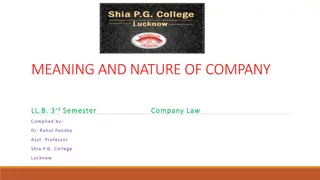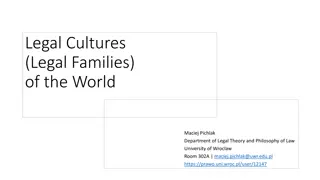Introduction to Macedonian Company Law by Associate Professor Kristina Misheva
This presentation explores the development of Macedonian company law within different legal systems, focusing on civil law, common law, and unifications of the law in a globalized economy. The discussion includes comparisons with other legal traditions and the distinct features of Macedonian company law.
Download Presentation

Please find below an Image/Link to download the presentation.
The content on the website is provided AS IS for your information and personal use only. It may not be sold, licensed, or shared on other websites without obtaining consent from the author.If you encounter any issues during the download, it is possible that the publisher has removed the file from their server.
You are allowed to download the files provided on this website for personal or commercial use, subject to the condition that they are used lawfully. All files are the property of their respective owners.
The content on the website is provided AS IS for your information and personal use only. It may not be sold, licensed, or shared on other websites without obtaining consent from the author.
E N D
Presentation Transcript
DERMATOLOGIC DISEASES Chapter 16
ECTODERMAL DYSPLASIA two or more ectodermally derived anatomic structures fail to develop: skin, hair, nails, teeth, or sweat glands hypohidrotic ectodermal dysplasia
Clinical features hypohidrotic ectodermal dysplasia X-linked inheritance male heat intolerance fever of undetermined origin baby Diagnostic aid: a special impression of the patient's fingertips , count the density of the sweat glands microscopically fine, sparse blonde hair (reduced density of eyebrow and eyelash) The periocular skin: Fine wrinkling with hyperpigmentation midface hypoplasia nails : dystrophic and brittle
Intraoral findings salivary glands (are ectodermally derived) xerostomia reduced number of the teeth (oligodontia or hypodontia) crown shapes are abnormal The incisor crowns tapered, conical, or pointed, the molar crowns reduced diameter Anodontia Female patients partial expression
Histopathologic Features Skin decreased number of sweat glands and hair follicles. The adnexal structures that are present are hypoplastic and malformed.
Treatment and Prognosis genetic counseling for the parents and the patient. dental problems prosthetic replacement of the dentition, dental implants
WHITE SPONGE NEVUS (CANNON'S DISEASE; FAMILIAL WHITE FOLDED DYSPLASIA) a defect in the normal keratinization of the oral mucosa (keratin 4 and keratin 13) relatively rare genodermatosis
Clinical Features usually appear at birth or in early childhood Symmetric, thickened,white, corrugated or velvety, diffuse plaques ,buccal mucosa , bilaterally Other intraoral sites: the ventral tongue, labial mucosa, soft palate, alveolar mucosa, and floor of the mouth Extraoral mucosal sites: nasal, esophageal, laryngeal, and anogenital mucosa Usually asymptomatic
Histopathologic Features characteristic but not pathognomonic Prominent hyperparakeratosis , acanthosis ,clearing of the cytoplasm of the cells in the spinous layer DD: leukoedema ,HBID an eosinophilic condensation in the perinuclear region of the cells :keratin tonofilaments Exfoliative cytologic studies may provide more definitive diagnostic information
Treatment & Prognosis a benign condition ---> no treatment prognosis : good
DYSKERATOSIS CONGENITA (COLEENGMAN SYNDROME; ZINSSER- COLEENGMAN SYNDROME) a rare genodermatosis usually inherited as an X-linked recessive trait Mutations in the DKC I gene disrupt the normal maintenance of telomerase
Clinical Features During the first 10 years of life A reticular pattern of skin hyper-pigmentation on the face, neck, and upper chest abnormal, dysplastic changes of the nails
Intraoral findings the tongue and buccal mucosa : Bullae erosions leukoplakic lesions The leukoplakic lesions : premalignant 1/3 become malignant (10-30y.) Rapidly progressive periodontal disease Thrombocytopenia (the first hematologic problem) 70% aplastic anemia
Histopathologic Features early oral mucosal lesions hyper orthokeratosis & epithelial atrophy After progress epithelial dysplasia, squamous cell carcinoma
Treatment and Prognosis Symptomatic careful periodic oral examinations Monitor the patient for aplastic anemia Genetic counseling
XERODERMA PIGMENTOSUM a rare genodermatosis numerous cutaneous malignancies develop at a very early age inability of the epithelial cells to repair UV damage mutations in the epithelial cells 1000 to 4000 times more skin cancer
Clinical Features Sunburn, Skin changes, such as atrophy, freckled pigmentation, and patchy depigmentation actinic keratoses SCC,BCC ,Melanoma(most frequently in the head and neck region) Oral manifestations: SCC of the lower lip and the tip of the tongue.
Histopathologic Features The histopathologic features of xeroderma pigmentosum are relatively nonspecific premalignant & malignant lesions are microscopically indistinguishable from those observed in unaffected patients.
Treatment and Prognosis Avoid sunlight & unfiltered fluorescent light ,wear protective clothing, sunscreens A dermatologist should evaluate the patient every 3 months to monitor the development of cutaneous lesions.























